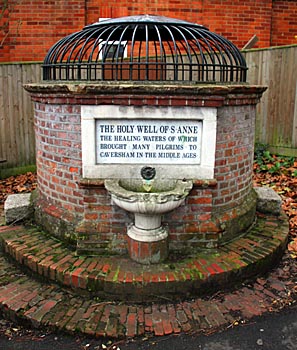 |
||||
|
|
 Caversham (in
Oxfordshire) Caversham (in
Oxfordshire)Of Shrines & Civil War Late 20th century discoveries of underground chalk caverns below the town indicate that Cavershamís name may imply just what it sounds like: Caveís Home. The Cell of Austin Canons, from Notely Abbey in Long Crendon (Bucks), who had their living at Caversham, did not have an official rank but the establishment was often known as Caversham Priory. It was founded in 1162, probably near Caversham Church which was given to Notely Abbey at that time by the local lord of the manor, Walter Giffard, 1st Earl of Buckingham. As Keeper of nearby Windsor Castle, he probably spent quite a lot of time here, even though he owned vast estates all over the country. It appears, however, that the Shrine to Our Lady of Caversham in the Chapel of St. Mary at the Priory may have existed prior to the foundation of the monastic cell and was later incorporated within it. Prince Robert, Duke of Normandy brought back a relic of Our Lordís passion from the Crusades in 1106 and through the widow of his companion, Countess Agnes of Buckingham, he gave it to the Caversham Shrine. Our Lady of Cavershamís Shrine was one of the great pilgrimage centres of Britain during the Middle Ages. In the worship of the Virgin Mary, it was second only to the great shrine at Walsingham (Norf). It was centred around a wonderful jewel-encrusted crowned statue of the Virgin, but it also housed an important collection of relics: There was the spearhead that pierced Christís side on the Cross (and described as the principal relic of the Realm) which may have been that given by Duke Robert, though it was said to have been brought to Caversham by an angel with one wing (probably a statuette which held the relic); then comes a piece of the rope with which Judas hung himself, and the knives that killed Saint-King Edward the Martyr (which may have been brought from Readingís Saxon nunnery) and King Henry VI. Pilgrims visiting the shrine, from the south, would first find a stopping place on Caversham Bridge, at St. Anneís Chapel. It has long gone, but similar Bridge Chapels are still to be seen at Bradford (Wilts), St. Ives (Hunts), Wakefield (Yorks) & Rotherham (Yorks). Also at the top of Priest Hill was St. Anneís Well, which was said to cure many afflictions. It was lost for many years, but restored early this century. The Chapel of Our Lady of Caversham may have moved to be within the walls of St. Peterís Church in later years. It was finally suppressed in 1538. Its original site is generally thought to have had the Old Rectory, alias Caversham Court, built upon it. Built around two courtyards, its beautiful timber-framing led to its nickname of the Striped House. It had a 1638 staircase, with bullet holes from a Civil War attack, and an elaborate decorated plaster ceiling. Both survived an almost total rebuilding programme by Pugin (1840) under the patronage of the great brewing Simonds family; but the house only lasted about a hundred more years and the area is now a public park. A small Norman font or stoup, now in St. Peterís Church, was found buried in the Old Rectory Gardens and may have come from St. Maryís Chapel. The North Aisle of St. Peterís has a roof not designed for its present location, which may have come from Reading Abbey. During the Civil War Siege of Reading, when King Charles I had his headquarters at Caversham Park, his Royalist troops stationed a cannon on top of the Church Tower. The parliamentarians quickly blew both it and the steeple to smithereens. Since 1911, Caversham has fallen within the region administered by Berkshire County Council and its successor, Reading Borough Council. See also Caversham Hamlets. |
|||
| © Nash Ford Publishing 2001. All Rights Reserved. This location has been administered by Berkshire Councils since 1911. | ||||


